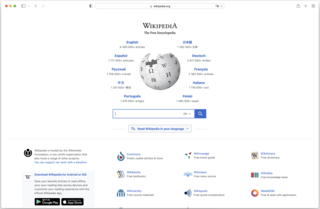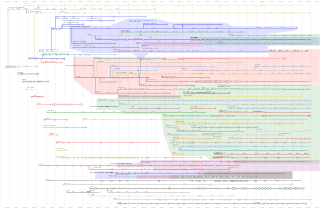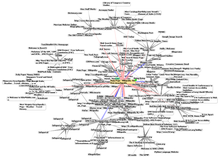
A bulletin board system (BBS), also called a computer bulletin board service (CBBS), is a computer server running software that allows users to connect to the system using a terminal program. Once logged in, the user performs functions such as uploading and downloading software and data, reading news and bulletins, and exchanging messages with other users through public message boards and sometimes via direct chatting. In the early 1980s, message networks such as FidoNet were developed to provide services such as NetMail, which is similar to internet-based email.

The history of the Internet originated in the efforts of scientists and engineers to build and interconnect computer networks. The Internet Protocol Suite, the set of rules used to communicate between networks and devices on the Internet, arose from research and development in the United States and involved international collaboration, particularly with researchers in the United Kingdom and France.

Sir Timothy John Berners-Lee, also known as TimBL, is an English computer scientist best known as the inventor of the World Wide Web, the HTML markup language, the URL system, and HTTP. He is a professorial research fellow at the University of Oxford and a professor emeritus at the Massachusetts Institute of Technology (MIT).

The history of video games began in the 1950s and 1960s as computer scientists began designing simple games and simulations on minicomputers and mainframes. Spacewar! was developed by Massachusetts Institute of Technology (MIT) student hobbyists in 1962 as one of the first such games on a video display. The first consumer video game hardware was released in the early 1970s. The first home video game console was the Magnavox Odyssey, and the first arcade video games were Computer Space and Pong. After its home console conversions, numerous companies sprang up to capture Pong's success in both the arcade and the home by cloning the game, causing a series of boom and bust cycles due to oversaturation and lack of innovation.

The World Wide Web is an information system that enables content sharing over the Internet through user-friendly ways meant to appeal to users beyond IT specialists and hobbyists. It allows documents and other web resources to be accessed over the Internet according to specific rules of the Hypertext Transfer Protocol (HTTP).

A web browser is an application for accessing websites. When a user requests a web page from a particular website, the browser retrieves its files from a web server and then displays the page on the user's screen. Browsers are used on a range of devices, including desktops, laptops, tablets, and smartphones. By 2020, an estimated 4.9 billion people had used a browser. The most-used browser is Google Chrome, with a 67% global market share on all devices, followed by Safari with 18%.

The 1990s was the decade that began on 1 January 1990, and ended on 31 December 1999. Known as the "post-Cold War decade", the 1990s were culturally imagined as the period from the Revolutions of 1989 until the September 11 attacks in 2001. The dissolution of the Soviet Union marked the end of Russia's status as a superpower, the end of a multipolar world, and the rise of anti-Western sentiment. China was still recovering from a politically and economically turbulent period. This allowed the US to emerge as the world's sole superpower, creating relative peace and prosperity for many western countries. During this decade, the world population grew from 5.3 to 6.1 billion.

NeXTSTEP is a discontinued object-oriented, multitasking operating system based on the Mach kernel and the UNIX-derived BSD. It was developed by NeXT Computer, founded by Steve Jobs, in the late 1980s and early 1990s and was initially used for its range of proprietary workstation computers such as the NeXTcube. It was later ported to several other computer architectures.

The Information Age is a historical period that began in the mid-20th century. It is characterized by a rapid shift from traditional industries, as established during the Industrial Revolution, to an economy centered on information technology. The onset of the Information Age has been linked to the development of the transistor in 1947 and the optical amplifier in 1957. These technological advances have had a significant impact on the way information is processed and transmitted.
Full-motion video (FMV) is a video game narration technique that relies upon pre-recorded video files to display action in the game. While many games feature FMVs as a way to present information during cutscenes, games that are primarily presented through FMVs are referred to as full-motion video games or interactive movies.

A browser war is a competition for dominance in the usage share of web browsers. The "first browser war" (1995–2001) occurred between proponents of Internet Explorer and Netscape Navigator, and the "second browser war" (2004-2017) between those favoring Internet Explorer, Firefox, or Google Chrome.

Robert Cailliau is a Belgian informatics engineer who proposed the first (pre-www) hypertext system for CERN in 1987 and collaborated with Tim Berners-Lee on the World Wide Web from before it got its name. He designed the historical logo of the WWW, organized the first International World Wide Web Conference at CERN in 1994 and helped transfer Web development from CERN to the global Web consortium in 1995. He is listed as co-author of How the Web Was Born by James Gillies, the first book-length account of the origins of the World Wide Web.

The Line Mode Browser is the second web browser ever created. The browser was the first demonstrated to be portable to several different operating systems. Operated from a simple command-line interface, it could be widely used on many computers and computer terminals throughout the Internet. The browser was developed starting in 1990, and then supported by the World Wide Web Consortium (W3C) as an example and test application for the libwww library.

Digitality is used to mean the condition of living in a digital culture, derived from Nicholas Negroponte's book Being Digital in analogy with modernity and post-modernity.

The World Wide Web is a global information medium that users can access via computers connected to the Internet. The term is often mistakenly used as a synonym for the Internet, but the Web is a service that operates over the Internet, just as email and Usenet do. The history of the Internet and the history of hypertext date back significantly further than that of the World Wide Web.
The mobile web comprises mobile browser-based World Wide Web services accessed from handheld mobile devices, such as smartphones or feature phones, through a mobile or other wireless network.

Alan Kotok was an American computer scientist known for his work at Digital Equipment Corporation and at the World Wide Web Consortium (W3C). Steven Levy, in his book Hackers: Heroes of the Computer Revolution, describes Kotok and his classmates at the Massachusetts Institute of Technology (MIT) as the first true hackers.

Erwise is an early discontinued web browser, and the first that was available for the X Window System.
A web browser is a software application for retrieving, presenting and traversing information resources on the World Wide Web. It further provides for the capture or input of information which may be returned to the presenting system, then stored or processed as necessary. The method of accessing a particular page or content is achieved by entering its address, known as a Uniform Resource Identifier or URI. This may be a web page, image, video, or other piece of content. Hyperlinks present in resources enable users easily to navigate their browsers to related resources. A web browser can also be defined as an application software or program designed to enable users to access, retrieve and view documents and other resources on the Internet.
A uniform resource locator (URL), colloquially known as an address on the Web, is a reference to a resource that specifies its location on a computer network and a mechanism for retrieving it. A URL is a specific type of Uniform Resource Identifier (URI), although many people use the two terms interchangeably. URLs occur most commonly to reference web pages (HTTP/HTTPS) but are also used for file transfer (FTP), email (mailto), database access (JDBC), and many other applications.

















